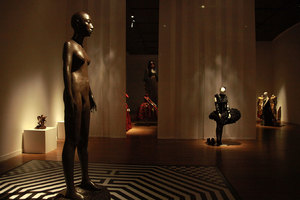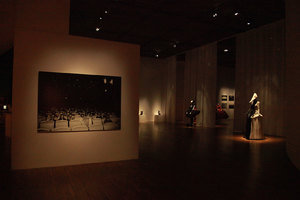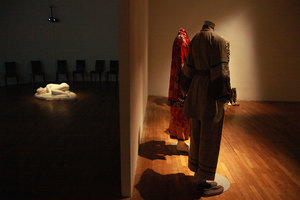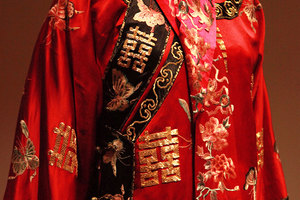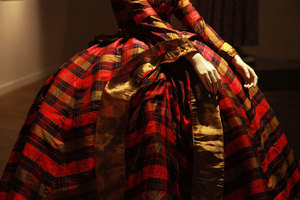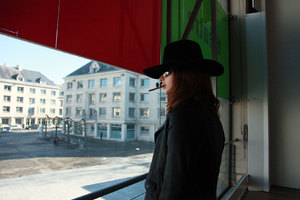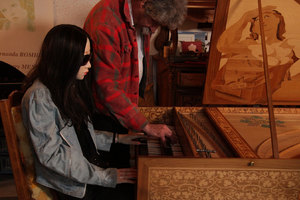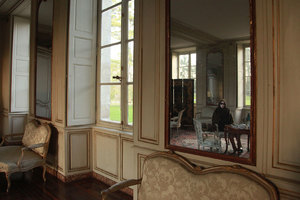In Parallel
Tim Yip Solo Exhibition, curated by Mark Holborn
February 17 to May 16, 2016 at Maison de la Culture d’Amiens
NOTES FROM A BATTLEFIELD
Mark Holborn
Tim Yip’s work in Amiens, a cathedral city in northern France, in early 2016 was inevitably shaped by a winter landscape where a century before the battle lines of a divided continent had been drawn. After the devastation of two world wars within less than half a century, numerous institutions were created to prevent the recurrence of such catastrophes. With the establishment of the United Nations, a greater sense of global cohesion was brought to the diplomatic table. Within weeks of the founding of the UN came the formation of UNESCO. The preservation and nourishment of culture was a natural aspiration in the aftermath of unbridled destruction.
With the accompanying collapse of old imperial values, Europeans looked beyond their borders to a greater sense of world history. Among such figures was André Malraux, who served as the first French Minister of Cultural Affairs under de Gaulle in the sixties. Malraux had an interest in Asian culture. At an early age he had explored the Cambodian jungle for lost Khmer temples. He was highly critical of French colonial attitudes in Indochina. Malraux acted as a visionary through whose guidance a group of satellite cultural establishments, Maisons de la Culture, were established beyond the metropolitan cultural hub of Paris. Notably a maison was founded in Amiens in 1966. It was here that Tim Yip made an ambitious installation. His international reputation was that of a gifted costume and set designer based in China. In fact, he is a major creative figure whose invention spans the divisions between East and West, between the Old World of Europe and the New World of Chinese culture at a time of radical metamorphosis. In a wider sense he operates between the historical tradition uncovered through his design research and the innovation necessary to place his productions in a contemporary framework. Though he is a great designer for film and theatre, his costumes, including several of those chosen for display in Amiens, transcend production briefs to exist as freestanding creations. He is an artist. He has applied the term New Orientalism to contain the breadth of his work. The choice of inviting Tim Yip to make an exhibition to mark the fiftieth anniversary of the Maison de la Culture in Amiens could not have been more appropriate.
Due to a negotiated agreement between the Pope and the Kaiser, the city of Amiens, in particular its thirteenth-century cathedral — enclosing the largest volume of cathedral space in France — was spared bombardment in the First World War. The looming shape of the building, perched high above the River Somme, can be seen for miles across the distant plains of the Picardy landscape. The cathedral stands as a timeless reminder of the passage of history and the constancy of the edifice in the face of surrounding violence, not least the events of the French Revolution. But during the Second World War the medieval glass of the cathedral windows was removed for safekeeping to a warehouse outside Paris. The warehouse took a direct hit. Even this disaster produced a glorious consequence. The windows that had once bathed the interior in dim polychrome glow were replaced with clear panes that allowed a light to illuminate the darker recesses and cast strong shadows in a manner the building’s creators would never have experienced. The cathedral dominates the town, much of which has been rebuilt, as it does the surrounding countryside. The cathedral acts as an immovable axis.
The second inescapable historical fact was that Amiens emerged and flourished beside the Somme. The opening of the Tim Yip exhibition preceded the centenary of the first day of the Battle of the Somme on July 1st. Nearly twenty thousand British troops were killed on that single day in 1916. The casualty figures for the whole battle reach hundreds of thousands. These are details that no visitor can ignore.
The First World War is epitomized in the European imagination as the war of the Western Front, yet it was truly a global conflict stretching from the waters of the South Atlantic to the deserts of Mesopotamia and colonial territories in Africa. Sikh and North African battalions fought alongside their British and French counterparts. Bengal lancers and Zulu warriors braved the mud of Europe. In 1916 The British and Chinese governments made an agreement for the transporting of a Chinese labour force to serve in France. They arrived in 1917 and by May 1919, some six months after the Armistice, 80,000 of the Chinese Labour Corps were still at work under British command. At least 2,000 died. Many were victims of an influenza epidemic that broke out after the cessation of hostilities. Outside the quiet village of Noyelles-sur-Mer, near the mouth of the Somme, is the official war cemetery for these Chinese dead. In this walled patch of ground beside the cultivated fields stretching to the wide horizon lie 838 Chinese, five thousand miles from their homeland. The cemetery is laid out with all the formality and elegance of the war graves architect, Edwin Lutyens. An inscribed Chinese gate marks the entrance.
I joined Tim Yip late in the summer of 2015 in exploration of the surrounding country. The Chinese cemetery was one of our first stops. An old villager told us of the misdeeds of the English and the cruelty inflicted on the Chinese. History shadows us all, however benign our intentions, and few of us are spared a sense of historical accusation. We inescapably belong to the tribe of the oppressed or are heirs to the oppressors. I was struck by the brilliance of Lutyens’ design that harboured this grief by virtue of its simplicity and dignity with the judicious planting of pine trees in the very centre, under which we could contemplate the enormity of the tragedy. For Tim Yip the scene must have been doubly poignant. Not only was Tim Yip a Chinese artist, he was raised in Hong Kong under the flag of British dominion. From the claustrophobia of Hong Kong he had escaped to Taiwan where he met the film director Ang Lee. After working on Crouching Tiger, Hidden Dragon, Tim Yip collected his Oscar and moved to Beijing. While he photographed obsessively among the gravestones in this corner of the Somme, one had to guess if the camera enabled him to see more clearly or if it shielded him. He photographs continually every day as if he negotiates surrounding chaos through a camera lens. The cemetery at Noyelles-sur-Mer was, for us, a beginning.
When we came to install the exhibition and Tim Yip returned to the cemetery to film, he had a companion. Lili is not only a traveller in this strange territory, she is faithfully present at such occasions and throughout Tim Yip’s various working excursions across Europe, China and Taiwan. She resembles a stereotypical eighteen-year-old Chinese woman. She nearly always wears dark glasses and has a variety of wigs and costumes. Her expression, though on the one hand fixed in its stare, is indeed completely flexible. In physical reality she is a manikin, yet she occupies a psychological space into which one can project from the deeper recesses of one’s own consciousness. She is a mirror, a cypher, a device, an inhabitant on the borderline with another dimension. Her unswerving presence in a multitude of locations, including the battlefields of the Somme on a bleak winter day or in the chill of Amiens cathedral, suggests a kind of alter ego from another zone transported here to bear witness. Lili in her monumental form, twenty feet high was the climax of the exhibition. Lili sleeping and dreaming in a foetal marble form was the finale. A naked bronze Lili, labeled Desire, wept tears of real water down her cheeks as she stood in perfect geometry in the middle of a labyrinth or maze that echoed that of the very centre of the cathedral along the route of which the penitents had once shuffled on their knees for redemption from their sins. A deconstructed, fragmented giant Lili lay on stones in a tomb-like chamber at the very start of the installation. The sign of her death marked the note on which the progression of the exhibition opened. In the film that Tim Yip made in the period of the installation, Lili’s shattered body is found lurking in the reeds by the marshlands at the edge of the river. She is seen again in the foreground of the Chinese cemetery, the gravestones behind her, rain thrashing her face, flowers blooming through her broken limbs.
Though Lili is now a familiar feature, it would be a mistake to think either that Tim Yip’s art is defined by Lili’s presence — she is but a fragment in a greater landscape — or that in the company of the artist Lili will not undergo further transformation. She is no more fixed than any human in a constant state of ‘becoming’. She is on the move to a city that embodies transformation, historical upheaval under forces of occupation, invasion and revolution in another kind of battle zone beside a great river that leads back to the cradle of a further historical culture. Shanghai awaits her.

